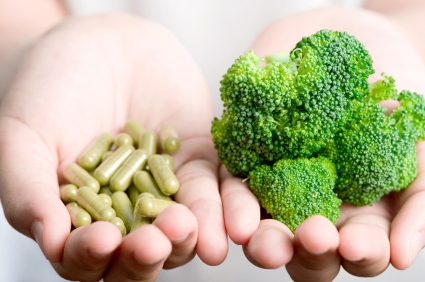Numerous studies show that even though most American’s get more than enough calories, a shocking ~90% don’t get enough of one or more vitamins and minerals in their diets. (1-5) This includes from the vitamins and minerals that are naturally occurring in our food, fortified and enriched foods, and dietary supplementation. For example, a comprehensive study published in 2012 by Centers for Disease Control and Prevention (CDC) estimates that, based on standard biomarkers of nutrient status, 30 million Americans (10.5%) have vitamin B6 deficiency. Additionally, 23 million Americans (8.1%) have vitamin D deficiency. (6)
Nutritional deficiencies can come from:
- high intake of hyper-palatable, sugary, processed foods
- chemicals and toxic substances
- soil depletion on farms that grow our food
- industrial food processing
- food storage conditions
- pharmaceutical medications
The good news is, as our collective understanding of the link between nutritional wealth and good health builds, more and more people are cleaning up their diets, addressing nutritional deficiencies, reducing toxic exposures, and cutting down on medication reliance. We are recognizing the value of simple things like deep sleep, hydration, whole food, stress reduction/management, and a plastic-free life. At the same time, the medical community is making a fairly significant paradigm shift and new ways of thinking and talking about medical care are starting to emerge.
A high quality, properly prepared, nutrient-dense diet matters. Ideally, what we put into our body doesn’t increase our toxic burden and has the necessary carbohydrates, fats, and protein, phytonutrients, minerals, and vitamins we need to maintain health. Eat organic, fresh, local, ingredients in their whole form, buy animal products that are 100% grass fed and pastured, and make sure your supplements are sourced from whole food ingredients.
Simple enough, right? Seems like it should be. However, even if we eat a wide variety of nutrient-dense foods, it’s really unlikely that we are getting all of the nutrients we require, regardless of our body’s unique nutritional needs. And that’s because our food is just not as nutrient rich as it once was. Soils are depleted due to decades of conventional farming, agriculture, and husbandry. In fact, “The Organic Consumers Association cites several other studies with similar findings: A Kushi Institute analysis of nutrient data from 1975 to 1997 found that average calcium levels in 12 fresh vegetables dropped 27 percent; iron levels 37 percent; vitamin A levels 21 percent, and vitamin C levels 30 percent. A similar study of British nutrient data from 1930 to 1980, published in the British Food Journal, found that in 20 vegetables the average calcium content had declined 19 percent; iron 22 percent; and potassium 14 percent. Yet another study concluded that one would have to eat eight oranges today to derive the same amount of Vitamin A as our grandparents would have gotten from one.” (7)
It is imperative to supplement our diet with vitamins and other essential nutrients which are missing in our food. Unfortunately, millions of people today are taking vitamin supplements as the only means to prevent nutritional deficiencies, believing that it actually compensates for poor eating habits and bad diets. It does not.

As a holistic nutritionist, I help my clients maximize the nutritional value of their food, reduce the substances that burden and deplete their system, and use targeted supplementation to fill in the gaps. Food contains a variety of nutritional wealth that we just can’t synthesize into pill form. However, targeted and bio-individual supplementation is an important part of any client’s protocol. To restore missing nutrients, most of us need therapeutic doses of one or more nutrients. To keep the system balanced, most of us need some supplementation on an ongoing basis.
We can improve the safety of supplementation by paying attention to the quality of our supplements, much the same way we do with our food. Ideally, we aren’t introducing substances that increase toxic burden, we absorb what we take in, and the ingredients used to make the supplement come from natural sources.
Natural is a bit of a problematic word. It has been used in marketing to mislead us into thinking that a product is good for us when it might not be. In this case, natural supplements or vitamins are derived from animal or plant material that actually contains the nutrient in question. The natural form comes along with other vitamins, minerals, and enzymes (cofactors) that help the body recognize, metabolize, and make use of the vitamins. Buyer beware: just because a bottle says natural doesn’t mean it meets these criteria.
The majority of vitamin supplements sold today are actually synthetic. Synthetic supplements are often much cheaper than naturally occurring, whole food supplements. Unfortunately, many synthetic vitamins are not recognized by the body in the same way as the natural version because they often lack the co-factors associated with naturally occurring vitamins. Furthermore, chemical sources for vitamin supplements include petrochemicals, coal tar, and chemically manipulated ingredients. These products are not only unnatural, but potentially very dangerous.
The human body cannot utilize vitamins at synthetic potencies. Whole food potencies are more optimal. Nature provides us with balance, complexity, and bioavailability but not with a high potency. Conversely, synthetic and crystalline (chemically isolated) vitamins always appear in high, unnatural potencies.
For maximum absorption, the form of supplement matters just as much as the cofactors. Listed in order from easiest to absorb to most difficult to absorb: liposomal (liquid) > lozenge > powder > chewable > capsule > tablet. (8)
I highly recommend that you examine any supplements that you are taking closely and make sure that you are taking a supplement that is high quality and made from naturally occurring ingredients. Look at the label carefully. If the vitamin concentrations are high and their natural sources are not listed, the supplement is most likely synthetic.
Also, be aware that if you purchase a supplement on Amazon, or any other third-party selling site, you cannot always be assured that you are actually getting what you think you are getting. There is widespread “relabeling” and really convincing counterfeit supplements on third-party selling sites. Be sure you are getting what you pay for.
Here are a few of my favorite Whole Food Supplement Brands:
Standard Process
Thorne
Designs for Health
Biotics Research
Here is a handy vitamin guide to help you make dietary choices to target your unique nutritional needs.
References:
1 Wallace TC, McBurney M, Fulgoni VL 3rd. Multivitamin/mineral supplement contribution to micronutrient intakes in the United States, 2007-2010. J Am Coll Nutr. 2014;33(2):94-102.
2 Bailey RL, Fulgoni VL 3rd, Keast DR, Dwyer JT. Examination of vitamin intakes among US adults by dietary supplement use. J Acad Nutr Diet. 2012 May;112(5):657-63.
3 Fulgoni VL 3rd, Keast DR, Bailey RL, Dwyer J. Foods, Fortificants, and supplements: Where do Americans get their nutrients? J Nutr. 2011 Oct;141(10):1847-54.
4 Bailey RL, Fulgoni VL 3rd, Keast DR, Dwyer JT. Dietary supplement use is associated with higher intakes of minerals from food sources. Am J Clin Nutr. 2011 Nov;94(5):1376-81.
5 Agarwal S, Reider C, Brooks JR, Fulgoni VL 3rd. Comparison of prevalence of inadequate nutrient intake based on body weight status of adults in the United States: an analysis of NHANES 2001-2008. J Am Coll Nutr. 2015;34(2):126-34.
6 CDC’s Second Nutrition Report: A comprehensive biochemical assessment of the nutrition status of the U.S. population; published in 2012 https://www.cdc.gov/nutritionreport/pdf/Nutrition_Book_complete508_final.pdf
7 Scheer R, Moss D, Dirt Poor: Have Fruits and Vegetables Become Less Nutritious? Scientific American, 2011 April; https://www.scientificamerican.com/article/soil-depletion-and-nutrition-loss/
8 Lynch B. (2018) Dirty Genes. New York: Harper One.
